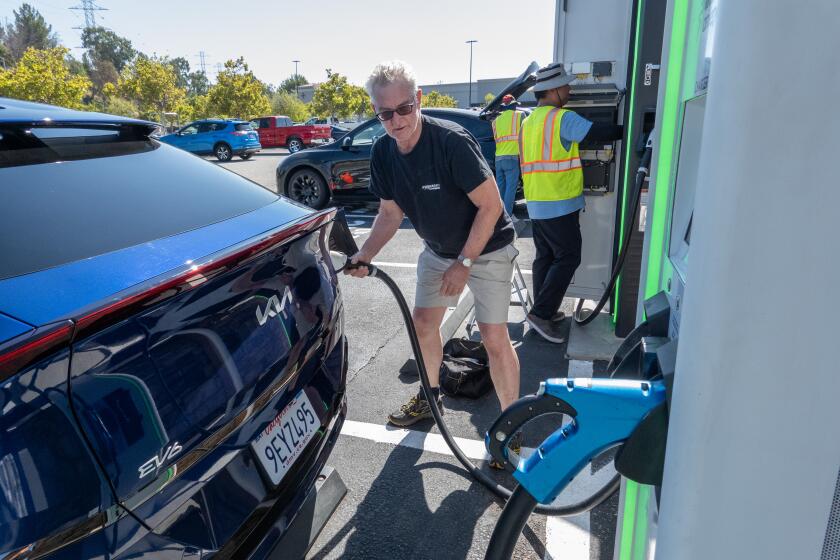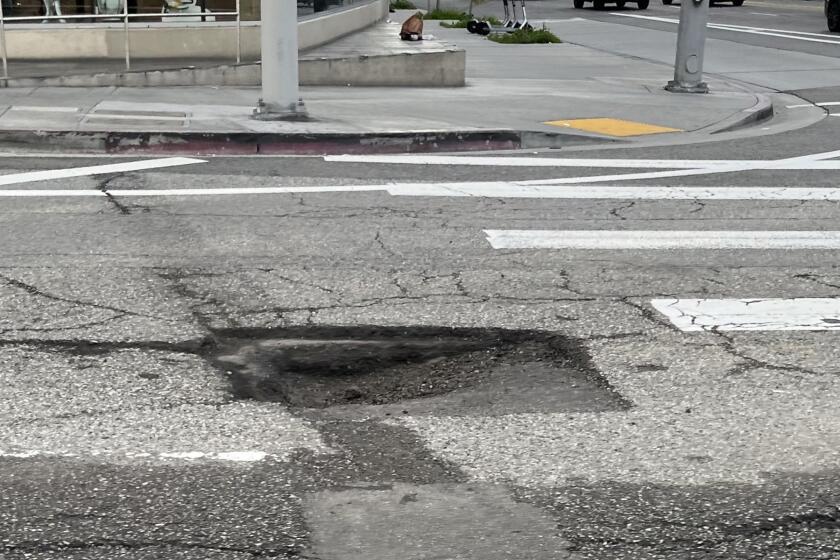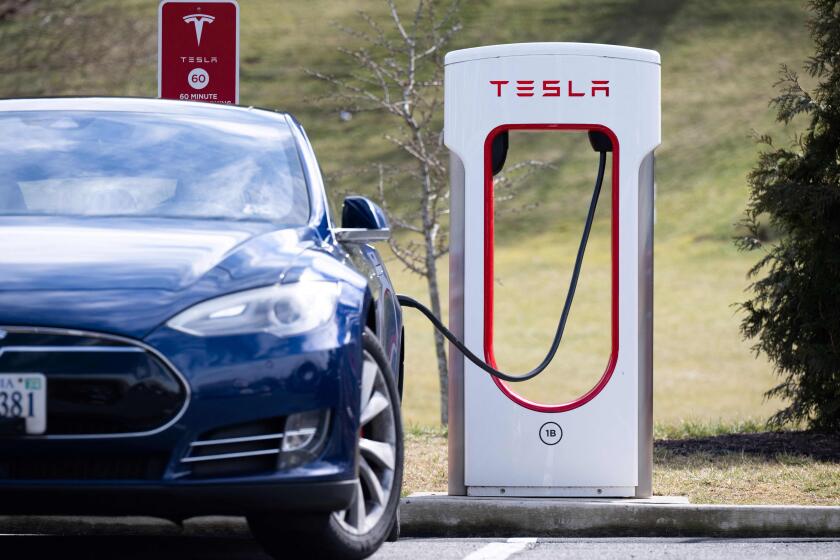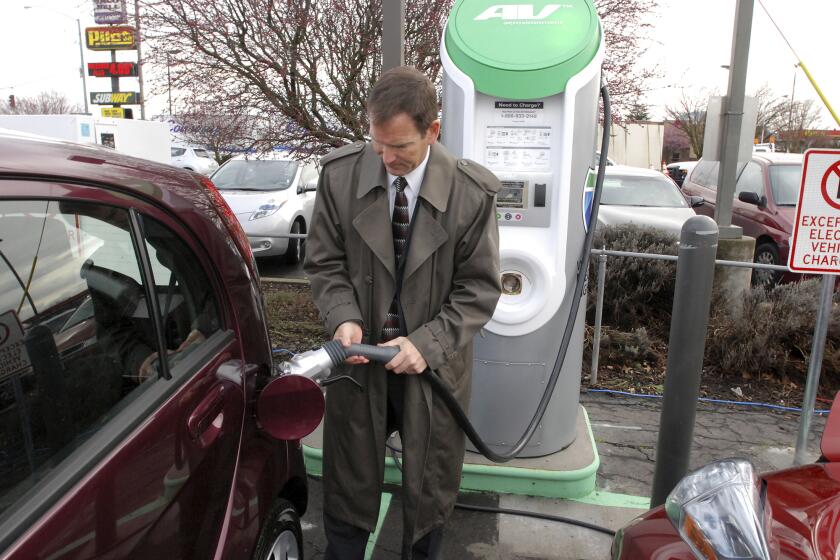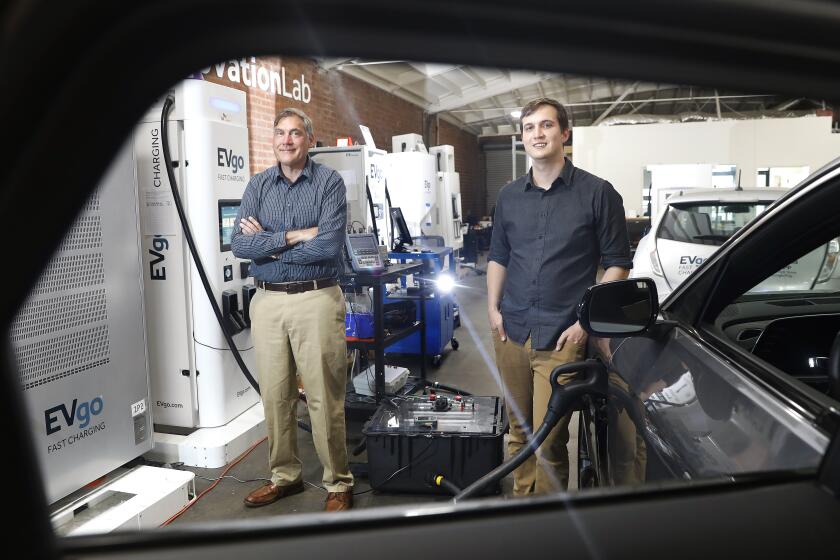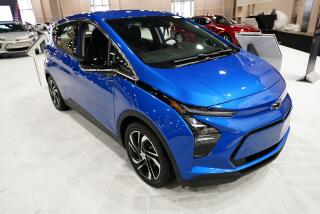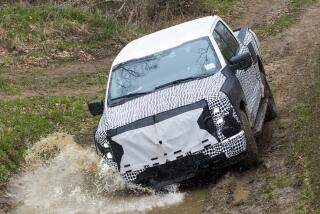Why your new electric car won’t have a spare tire. And why you probably don’t need one
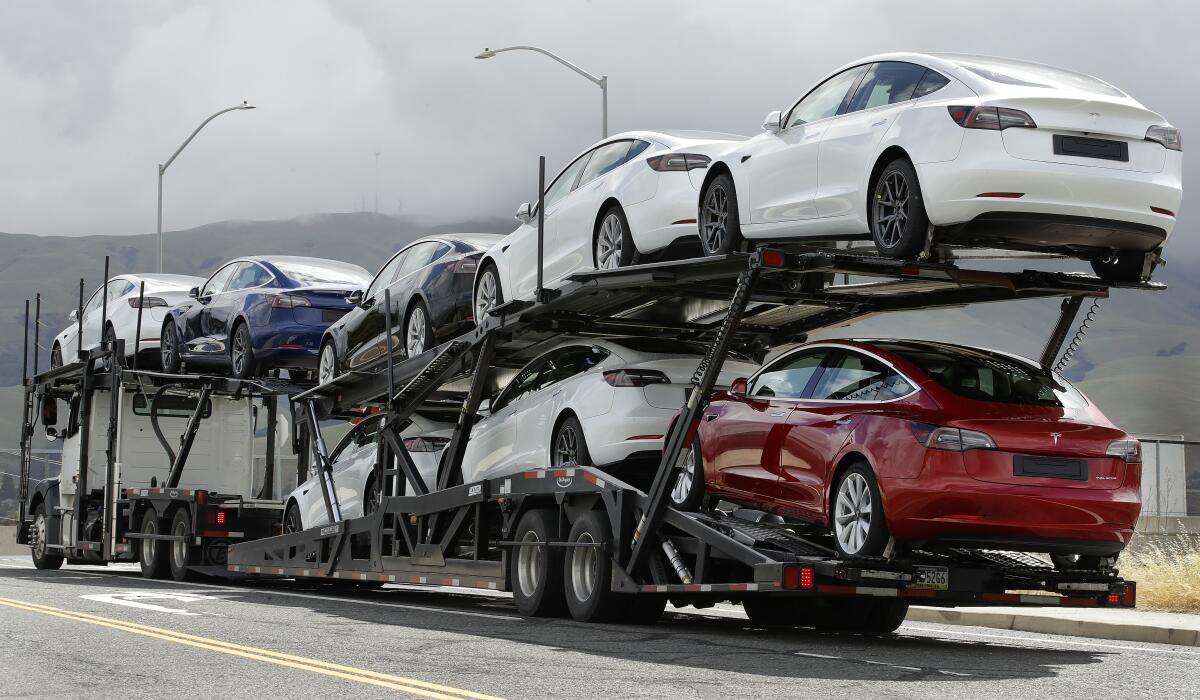
- Share via
Ira Newlander of West Los Angeles has been thinking about replacing his 1997 Ford Explorer with a hybrid or fully electric car, but there’s something bugging him about the market these days.
Like many Californians who’ve been waylaid by a flat tire far off the beaten path, Newlander wants his new car to come with a spare. But the vast majority of battery-powered and hybrid cars don’t have one.
Newlander expressed his frustration to Honda in a recent email, urging the company to put a full-sized spare in its electrified cars.
“I have conducted an informal survey of family and friends,” Newlander, a retired court reporter, wrote. “The consensus is that saving 40 or 50 pounds for a full spare on a vehicle weighing 1.5 to 2 tons is silly. It is immaterial compared to the risk of being caught in the middle of nowhere without a real spare. It turns a discussion about the spare into a discussion of despair.”
In response, Honda’s customer service told Newlander that “the reason why the spare tire isn’t included on our new electric vehicles is actually a safety concern.”
“The problem is if the vehicle is in an accident, the spare tire can cause damage to the electric battery which could cause a failure in the battery,” the company’s email explained.
Car design experts said that explanation was plausible but far-fetched. There’s a simpler explanation for the move away from spare tires: They’re too big and heavy, and people don’t really need them anymore.
Here’s a rundown of the issues that are keeping spares out of the new generation of battery-powered cars.
As autos writer for the L.A. Times, Russ Mitchell gets a lot of questions about electric car buying. Here’s his guide to choosing the right EV for you.
The disappearing spare phenomenon
Car manufacturers have been ridding their sedans and smaller SUVs of full-sized spares for some time. In 2018, Consumer Reports said, 60% of the vehicles it had tested over the previous five years came with small-sized temporary tires (“doughnuts”), and only 10% came with full-sized spares.
Increasingly, however, cars are skipping the doughnut in favor of run-flat tires (tires you can continue driving on after a puncture), puncture kits, roadside assistance or ... nothing.
The best-selling models of electric sedans and SUVs — Teslas, the Chevy Bolt, the Volkswagen ID.4, the Ford Mustang Mach-E, the Hyundai Ioniq 5, the BMW i4 and the Mercedes EQS — have no spare of any kind, even if they come with a premium price tag. Ditto for hybrids; the Toyota Prius, for example, hasn’t included a spare since 2016.
That’s not because people magically stopped having flat tires. U.S. drivers suffer 94 million flat tires a year, according to LookupAPlate.com, a site that collects reports about bad drivers.
Rain breeds potholes in aging roads around Southern California. You can file a claim for damage your car incurs, but reimbursement is not guaranteed.
The competition for space
Although you can still find spare tires on some trucks and large “adventuring” SUVs, one issue for carmakers is ever-increasing wheel sizes on new cars, said Geoff Wardle, executive director of transportation systems and design at the ArtCenter College of Design. “Try finding a suitable space in a Range Rover or Jeep Wagoneer for an 8-inch by 22-inch rim shod with a cross-country tire,” he said.
That’s why many manufacturers have switched to alternatives, such as inflatable spares that take up about a third of the volume of a full-size tire. Or they may equip their cars with self-sealing or run-flat tires, which Wardle said are “good if it is just a puncture from a nail but useless if you hit a pothole and split the rim and sidewall.”
Finding space for a spare is particularly challenging for a car powered by something other than gasoline, designers say. “Pushing the range of EVs requires batteries, electrical systems control units or hydrogen tanks to encroach into the traditional places that spare tires are found: under the trunk floor,” Wardle said.
The space crunch is worse for hybrids, which require room for both a battery system and an internal combustion engine, said Scott Grasman, dean of the College of Engineering at Kettering University in Flint, Mich.
As EV adoption picks up in states experiencing record high temperatures, drivers are learning to protect battery health.
The urge to lose weight
A full-sized spare adds 30 to 50 pounds to a car, Wardle said; a typical doughnut adds about 25 pounds. When car manufacturers are trying to meet ever more stringent emissions and fuel efficiency requirements, Wardle said 30 to 50 pounds of spare tire “is significant.”
“You might think that’s trivial” when compared to the weight of a car, Grasman said. But “if you’re trying to eke out every bit of range that you can, having a 25-pound tire in there is extra weight you’re just carrying around,” he said.
Gil Tal, director of the Electric Vehicle Research Center at UC Davis, said removing the spare probably increases an electric car’s range by “point something” percent. “If it’s a 400-mile car, it’s [an extra] mile or two,” he said. But after a manufacturer takes all the easy steps to boost range, he said, it’s left to scrape out more miles, however it can.
The drive to cut costs
Equipping a car with a spare tire increases the cost of building it. Grasman estimated that adding a full-sized spare costs the manufacturer $100 to $300, depending on the vehicle.
And tires for an EV may be more expensive than those for a gas-powered vehicle of the same size. That’s because EVs tend to be heavier than their gas-fueled counterparts, so they require sturdier tires. And with comparatively quiet engines, they need tires that don’t generate as much road noise.
Seven automakers unit to build an EV charging network they say will rival Tesla’s and nearly double the number of fast-charging plugs in the U.S. and Canada.
Do spares pose a safety threat in EVs?
Honda didn’t respond to a request to elaborate on the email sent to Newlander, so it’s hard to tell what it thought the safety issue might be.
Tal of UC Davis was skeptical that manufacturers were leaving spares out of their hybrids and EVs for that reason. “To the best of my knowledge,” he said, “it has nothing to do with safety.”
Wardle said that with a heavy spare wheel positioned near an elaborate and heavy battery assembly on the underside of the trunk, “there is a danger that in a severe frontal impact — a head-on crash — that spare wheel could break away from its retaining bolt and become a projectile that rips through the battery unit. So as well as the risk of injury to passengers and bystanders from the actual collision forces, there is the potential of short-circuiting and explosive overheating of the high-voltage battery unit.”
Grasman acknowledged that, while unlikely, it’s possible that a spare could do something bad to a battery in an accident. But he added, “You could change the design of the vehicle to make sure that didn’t happen.”
He also wondered why Honda would want to suggest that a spare could damage the battery in a collision.
“What about the headrest, what about all the cargo I stick in my trunk?” Grasman asked. “They’re kinda opening themselves up, I think.”
As the market for electric vehicles expands, the reliability record for public EV chargers is poor, causing many would-be EV buyers to question whether it’s time to make the switch.
Do you really need a spare?
Tal said that tires are much better and more durable than they used to be. And because federal regulations require new cars to have tire pressure indicators, he said, drivers are alerted as soon as their tires need air.
“In most cases, flat tires ... are the outcome of long low-pressure driving,” he said. “And if you drive a modern car, it will tell you [that] you have low pressure long before you get into the catastrophic failure” of a flat.
Many cars without spares come with kits to patch and reinflate a tire that’s low on air. But even when a tire does go flat, Tal said, “the most common behavior today is calling AAA and sitting in your car and playing on your phone.”
That’s the behavioral side of the equation, Grasman said. “People don’t know how to change a spare tire, so they’re not going to do it anyway,” he said.
For these drivers, carmakers may safely assume that a can of Fix-a-Flat will be more useful than a spare, a jack and a tire iron. Alternatively, manufacturers can offer roadside assistance for free (as Tesla does) or for a fee (through services like OnStar, which is owned by General Motors).
Newlander said it’s self-serving for carmakers to argue that people don’t need a spare. “For driving around town or short distances or during daylight hours, it’s one thing” to go without a back-up tire. “But for a nighttime return from San Diego, say, or Mammoth, I don’t think so.”
He has some experience on that front. “We had a flat tire in the mountains, I don’t know, 10 years ago,” he said. “It was fine because we had a spare tire.”
About The Times Utility Journalism Team
This article is from The Times’ Utility Journalism Team. Our mission is to be essential to the lives of Southern Californians by publishing information that solves problems, answers questions and helps with decision making. We serve audiences in and around Los Angeles — including current Times subscribers and diverse communities that haven’t historically had their needs met by our coverage.
How can we be useful to you and your community? Email utility (at) latimes.com or one of our journalists: Jon Healey, Ada Tseng, Jessica Roy and Karen Garcia.
More to Read
Inside the business of entertainment
The Wide Shot brings you news, analysis and insights on everything from streaming wars to production — and what it all means for the future.
You may occasionally receive promotional content from the Los Angeles Times.
